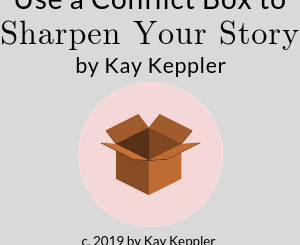Making It Happen: Characters with Agency by Kay Keppler
 Let’s welcome back monthly columnist, editor, and novelist, Kay Keppler, as she shares with us “Making It Happen: Characters with Agency.” Enjoy!
Let’s welcome back monthly columnist, editor, and novelist, Kay Keppler, as she shares with us “Making It Happen: Characters with Agency.” Enjoy!
***
At its heart, a traditional story is fairly simple. It goes like this.
You create a main character, a protagonist, who has an important goal. You create an antagonist, who has a different goal, equally important, that clashes with the protagonist’s goal. That clash as these characters interact and do their best to thwart each other, is your conflict.
It sounds so easy! But of course, it isn’t, and one reason is because it can be difficult to separate character goals from motivations.
The goal—no matter what it is—is something that the character has to have at all costs. It could be developing a life-saving vaccine or learning to swim. It doesn’t matter. The goal propels the action.
Motivation Defines Character
The reason your protagonist wants the goal is her motivation.
Let’s say our young protagonist’s goal is to learn to swim. Her motivation tells readers why.
Maybe the cute boy from math class is enrolled in the class, or maybe she wants an hour away from her parents, who are in the middle of a divorce, or maybe she wants to do even one thing her big sister can’t do.
Her motivation defines her character, but her specific goal—learning to swim—drives the story.
Motivation—your character arc—is internal; the goal—your plot arc—is external.
Characters with Agency: In Action with A Clear Goal
Motivation is your character sitting and thinking; the goal is your protagonist in action.
The goal, and your character’s striving for it, is what gives your story motion, what keeps your conflict active and interesting.
So when you’re shaping your protagonist’s goals, they should be pursuits, not avoidances; positive, not negative.
What does s/he want more than anything?
Make it a positive goal: She wants to learn to swim.
The actions that she takes in the pursuit of this goal are your plot. When she strives for something; she’s driving her own destiny. She has agency, and that makes her interesting. You want to root for her.
However, watch out for negative goals.
Negative goals are character statements like “I don’t want…” or “I want to make sure this never happens again.”
Negative goals make your protagonist more passive and a lot less interesting.
Instead of “I want to learn to swim,” which is a positive goal, our aspiring swimmer might say, “I don’t want to sit around all summer and be bored.” That’s a negative goal, and story-wise, there’s no place you can go with that. Both you and your characters will flounder, looking for something to do.
Why Stories Often Bog Down
Stories often bog down because the conflict falters, and that happens because we lose sight of our character’s goal.
If that happens to you, see if you can break the goal into intermediate steps or scenes that can be achieved (and thwarted) step by step.
In this case:
[MAIN GOAL] Our hopeful swimmer, let’s call her Meg, wants to learn to swim.
[setback] Her parents say that Meg has to earn the money for swimming lessons herself.
[INTERMEDIATE GOAL] She can earn the money babysitting.
[setback] Her sister, Susan, takes away her steady babysitting job
[INTERMEDIATE GOAL] Meg can get another babysitting job! She advertises her services in the local newspaper and gets a new job that pays more.
[setback] Susan takes Meg’s savings and buys a sweater with it.
[INTERMEDIATE GOAL] Meg returns the sweater to the store to get the money back.
[setback] When she speaks to the store clerk, she doesn’t have the receipt and the clerk thinks she stole it.
And so on. Notice that motivation does not enter into the action at all. No sitting and thinking for our Meg!
Actions Drive Story
The actions of your characters drive your story.
If your characters are passive or have negative goals—or their actions are off the page or you get bogged down in motivation instead—your story will slow to a standstill.
If you let Meg mope around until her parents decide they can afford swimming lessons after all, readers might feel sorry for her, but they probably won’t invest any time or emotion in her.
Readers have to care about your characters. They have to worry about them and want to find out what they do next. And that’s why our Meg must try and fail and try again.
***
ABOUT THE AUTHOR
 Kay Keppler is an author Zero Gravity Outcasts, Betting on Hope, Gargoyle: Three Enchanting Romance Novellas, and editor of fiction and nonfiction –Angel’s Kiss and Outsource It!
Kay Keppler is an author Zero Gravity Outcasts, Betting on Hope, Gargoyle: Three Enchanting Romance Novellas, and editor of fiction and nonfiction –Angel’s Kiss and Outsource It!
She lives in northern California. Contact her here at Writer’s Fun Zone in the comments below, or at kaykeppler@yahoo.com to ask questions, suggest topics, or if you prefer, complain.
***
More popular articles by Kay Keppler on Writer’s Fun Zone:






